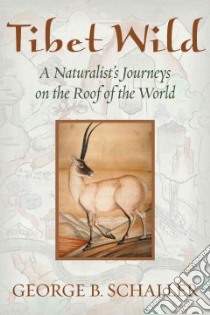Tibet Wild - 9781610911726
Un libro in lingua di Schaller George B. edito da Island Pr, 2012
- € 40.40
- Il prezzo è variabile in funzione del cambio della valuta d’origine
Before Dian Fossey and Jane Goodall, there was George Schaller. Schaller has spent more than half a century walking into the wildest places on Earth to lie down with animals; he first did so with mountain gorillas in an era when people believed they were monsters that would kill a man on sight, and reported to the world the slow joy of their family lives and their penchant for wild celery. He has written pioneering books on many of the wild creatures that have captured the public's imagination: gorillas in the mist, lions and wildebeest in the Serengeti, snow leopards in the Himalayas. Their fame and protection often trace back to a George Schaller book. In an era when the National Geographic Society gives its Explorer Awards to computer specialists in labs, Schaller is an anachronism, and he knows it. This book may be his swan song: the last of the classic Western naturalists travels to perhaps the last place on earth inhabited but not controlled by humans: the cold desert plains of Tibet. The book centers on the animals who astonishingly survive here in numbers, especially chiru an antelope that may be the legendary unicorn. Schaller looks at whole systems, including the lives of people. As a naturalist who has watched wilderness for so long, he knows we are witnessing a worldwide mass extinction; he sees Smithsonian scientists help US Congressmen go on safari to shoot endangered species, corrupt regional politics, and an exploding human population. This is not often a cheery book. But Schaller also sees small changes having positive effects, and is the ideal wilderness travelling companion: observant, honest, unsentimental, without ego or bigotry, and joyful in the beauty of small things. He walks on without pretense, a renowned Western scientist motivated by the desire to be in wild places, consistently transferring his authority to indigenous scientists, herders, hunters, and farmers protecting their native lands. Beautifully written, the book offers breathtaking natural history, and the human side of daily life in zones we only know from war and conflict (Afghanistan, Pakistan, the Tibet-China border). In the end, the author finds hope in Tibetan Buddhist monasteries that have created wildlife reserves for centuries, and are now starting conservation organizations. Readers may find hope in Schaller's example of a life dedicated to saving a planet where chiru, tiny rabbits, snow leopards, and human beings of every race, gender, and nation are all animals working to survive. Annotation ©2012 Book News, Inc., Portland, OR (booknews.com)
Informazioni bibliografiche
- Titolo del Libro in lingua: Tibet Wild
- Sottotitolo: A Naturalist's Journeys on the Roof of the World
- Lingua: English
- Autore: Schaller George B.
- Editore: Island Pr
- Collana: Island Pr (Hardcover)
- Data di Pubblicazione: 03 Ottobre '12
- Genere: NATURE
- Argomenti : Natural history China Tibet Autonomous Region
- Pagine: 372
- ISBN-10: 1610911725
- EAN-13: 9781610911726


